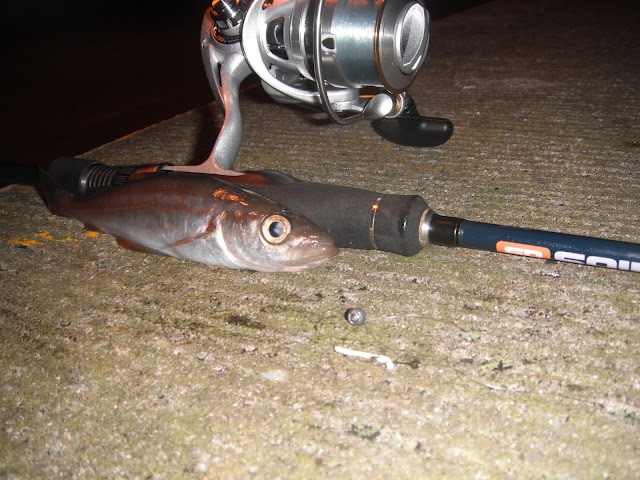I came across this article on bassdozer.com the other day and thought it would be worth sharing although it is primarily aimed at the American freshwater bass scene, I think that the majority of it is very applicable to the majority of the H.R.F. and Seabass fishing that we do...........
Note With a pegged bullet or screw-in sinker, it can be important to thread the hook eye up to an inch or more into the bait. This leaves room so the hook eye is not jammed immovably against the sinker. Otherwise, if the eye is pressed against the sinker, gripped inside the fish's tightly-clamped mouth, then you only move the entire bass/weight/hook forward without penetrating on the hookset. Leaving up to an inch or more of slack ensures enough room to move the hook and have it start to set before it jams up behind the sinker.
* These sinkers are products of Mojo Lure Company, Inc.
Mojo Rig Mojo sinkers are long and thin. The sinker shape allows a Mojo rig to slide easily through rocks, weeds, and brush better than most other sinker types. Mojo rigs also work for vertical fishing in deep water where baits are suspended for bass lurking in or under the tops of flooded trees or brush. They are part of a complete system that includes rubber strands that thread through the sinker to peg it from 12" to 24" inches up the main line above the bait. The rubber strands cushion the line from any potential damage that can occur with wooden toothpicks or crimping splitshots on the line.
* These sinkers are products of Mojo Lure Company, Inc.
Carolina Rig Most often used on open, relatively unobstructed bottom. Thread a 1/2 to 1 oz sinker onto your main line, followed by a bead that clicks when the sinker hammers against it. Then tie on a swivel, an 18"-24" inch leader line (but can be longer), and your hook. As with all the rigs we describe here, use lighter weights of Carolina rigs with light tackle, and heavier weights of Carolina rigs with heavier rods, reels and lines, a simple principle.
* These sinkers are products of Mojo Lure Company, Inc.
Rockhopper Rig An advancement over the Carolina rig for rock-strewn bottoms. The Rockhopper sinker can come through snags that stop most other sinker types.
* These sinkers are products of Mojo Lure Company, Inc.
Splitshot or Slipshot Rig Knot a hook to the end of your line and pinch one or more split shot 18" to 24" inches above the hook. Keep in mind, don't pinch the splitshot shut so tightly that you risk damaging the line. The Mojo Slipshot is an advancement that uses rubber threads to cushion the line. If not used in snaggy areas, simply nose-hook the bait with a hook like Yamamoto's series 53 Crooked Hook.
A splitshot rig is most often used with light line. Since splitshot sinkers are typically smaller and lighter than any other sinker types, you can slowly drift a splitshot rig down past bass suspended in mid-depths above deep water. A splitshot can be used for a delicate lightweight presentation in shallow water, or to sweep a bait down with the current flow in a stream or shallow river. The bait will swirl and sway as it is buffeted around by the water flow while the splitshots keep it hunkered down near bottom!
* These sinkers are products of Mojo Lure Company, Inc.
Dropshot Rig Tie a hook like a Yamamoto series 53 Crooked Hook onto the main line with a Palomar knot. The loose tag end of the knot is left anywhere from 12" to 24" inches long. After the knot is tied, the tag end is threaded through the hook eye in the direction that keeps the hook point positioned up. A swiveling style of sinker is then clipped onto the dangling tag end of the line anywhere from 6" to 24" below the hook. The bait is then nose-hooked. Optionally, the bait can be wacky-rigged in the middle to reduce any line twist that may occur with dropshot rigs.
Wacky Rig Tie a hook like Yamamoto's series 53 Crooked Hook to your main line. Use a long thin bait such as a Senko. Bend the bait in the middle so both tips touch. Then poke the hook straight through the bend in the middle.
That just about covers all the most popular rigs in modern use for soft baits. All you need to do now is get out on the water and learn to use them well. Practically any rig shown will work (within reason) with practically any model of soft plastic bait
Tight lines
Jay




















